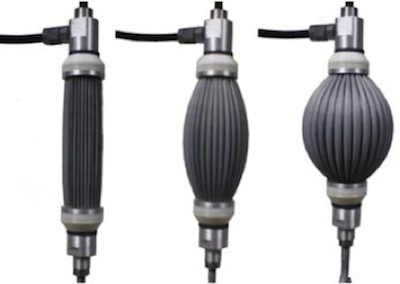Vrije Universiteit Brussel
Pneumatic artificial muscles (PAMs)One of the major problems of robotics and especially legged machines is the need for high force/torque to weight and high power to weight ratios of the actuators combined with relative low actuation rate. Aiming to develop such lightweight actuators, the multibody mechanics group started studying pneumatic artificial muscles in 1995. Pneumatic artificial muscles are contractile devices operated by pressurized air. When inflated, they bulge, shorten and thereby generate a contraction force. The force depends on the applied pressure and on the muscles length, ranging from an extremely high value at maximum length, i.e. zero contraction, to zero at minimum length or maximum contraction. Because of the one-way force a paired or antagonistic set-up is needed in order to generate a restoring force or movement. The PAM developed by the group is characterized by its pleated shape, allowing bulging to happen free of material deformation and friction. Its non-linear force-length relation is directly proportional to the applied pressure. Energy losses are reduced to a strict minimum. PPAM 1.0The membrane of the first generation is a fabric made of an aromatic polyamide such as Kevlar to which a thin liner is attached in order to make the membrane airtight. The high-tensile longitudinal fibres of the membrane transfer tension, while the folded structure allows the muscle to expand radially while unfurling upon inflation. Due to its specific design, the PPAM can easily work from pressures as low as 20 mbar to 4 bar gauge pressure and it can reach contractions over 40%, depending on its original dimensions (theoretically 54% for an infinitely thin muscle). The muscle prototype built by Daerden has a weight of about 100 g while it can generate forces up to 5 kN. PPAM 2.0The second generation of PPAM was introduced as a solution to the leakages which caused an insufficient lifespan, the membrane composition was changed. Instead of the Kevlar fabric, another more flexible material is used to create the folded membrane while the generated tension is transferred by individual high-tensile stiffness fibres that are only positioned at the bottom of each crease. Lifespan tests were performed, at which muscles moves up and down a load of 130 kg by a slow varying gauge pressure between 1 and 3 bar. The lifespan of the second generation of PPAM was proved to be longer than that of the previous design. About 400,000 cycles were reached before one of the tests was ended. Key publication
Second Generation Pleated Pneumatic Artificial Muscle and Its Robotic Applications
PPAM 3.0The third generation of PPAM, which is presented in this paper, has been developed to simplify the manufacturing process and to avoid muscle failure. The new step was partially promoted by the accessibility of Fused Deposition Modeling (FDM) rapid prototyping technology, which is used to make more complex, cheaper, and more lightweight end closures. The new production process and the use of new materials introduce improvements such as 55% reduction in the actuator's weight, a higher reliability, a 75% reduction in the production time and PPAMs can now be produced in all sizes from 4 to 50 cm. In the following publication, a comparison with experiments between PPAM and Festo 20 McKibben muscles is discussed. Key publicationThird Generation Pleated Pneumatic Artificial Muscles for Robotic Applications: Development and Comparison with McKibben MuscleAuthors: VILLEGAS CASI Daniel, VAN DAMME Michael, VANDERBORGHT Bram, BEYL Pieter, LEFEBER DIRK Reference: Advanced Robotics, issue 11-12, vol.26, pp.1205 - 1227, 2012 abstract and link publisher pdf full paper
|
||||||||||||||||||||
©2019 • Vrije Universiteit Brussel • Dept. MECH • Pleinlaan 2 • 1050 Elsene
• Tel.: +32-2-629.28.06 • Fax: +32-2-629.28.65 • webmaster


